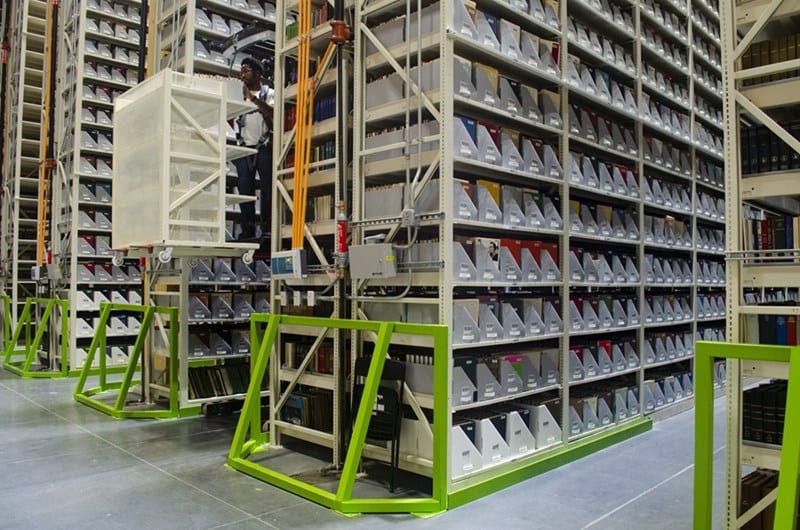University Libraries’ new high-density annex opened this summer, providing a climate-controlled environment for the university’s growing library collection of books and other materials, while freeing up needed space in Mullins Library, the main research library on campus.
Books and other materials from the annex are now being delivered to campus four times per day during the week and once per weekend, and Libraries faculty and staff are gearing up for the upcoming Mullins Library renovation.
No books or journals were discarded during the move to the annex, and the increase in space will allow the Libraries to continue expanding their collections. Advances in the electronic search and browsing functions of the Libraries’ catalog also benefit patrons of the Libraries.
For the next year, Level 1 of Mullins Library will contain call number ranges A-P from the main collection, musical scores, and the Special Collections department. Level 2, the lobby level, will house the main reference collection, the government documents reference collection, census materials, the performing arts and media reference collection, Learning Resources for Children, Razorback yearbooks and university budgets. Services, viewing equipment and reserve materials formerly housed in the Performing Arts and Media department have been moved to the Lindley and Kaneaster Hodges Jr. Reading Room on Level 2. The east side of Level 3 will be home to call number ranges Q-Z and U.S. documents.
The Libraries’ plans for the renovation include the creation of a makerspace and a multimedia lab. Increased and enhanced study spaces for groups and individuals will also be made available.
The west side of Level 3 and Level 4 will be inaccessible during the renovation.
The university’s enrollment has nearly doubled in the last 20 years, creating higher demand for areas to access electronic resources, study areas, interdisciplinary collaborative spaces and creative workspaces.
Use of print materials in the University Libraries dropped by 68 percent in the past decade, dropping from 96,028 checkouts in 2007 to only 30,765 last year. Meanwhile, downloads of electronic books have increased substantially, totaling more than 475,000 in 2017, not including hundreds of thousands of additional downloads of electronic articles, chapters, papers and more that make up the majority of the research queries for University Libraries’ materials.
The Libraries have maintained an off-site annex for more than 20 years to bolster the total storage capacity offered by the campus’ main library and four branch libraries. Books were retrieved from the off-site facility twice a day in the past, but the frequency has increased to four times per day for the new annex, providing better service and access than ever before.
A 2009 study of Mullins Library helped shape potential solutions to the growing challenges of space, emerging technologies and the Libraries’ growing collection. Campus input is helping to guide the planning for the renovation of Mullins Library and the transfer of books to the new storage facility. Campus feedback has included discussions by the Faculty Senate’s Library Committee, two open campus forums for students and faculty, and separate faculty strategy sessions.
The main library renovations are scheduled to begin in January 2019. After the completion of the renovations, a core collection of at least 500,000 volumes will remain in the campus’ five libraries, and access to all of the Libraries’ more than 2.4 million volumes will always be available.
Perry Dean Rogers Architects, of Boston, led the construction of the new annex and will lead the renovation of Mullins Library. The firm specializes in renovating academic libraries to accommodate the needs of twenty-first century students, faculty and researchers. Miller Boskus Lack is the local architecture firm working with Perry Dean Rogers Architects. ConReal is the general contractor.
Information about the annex and renovation is available through an FAQs -style online resource.
